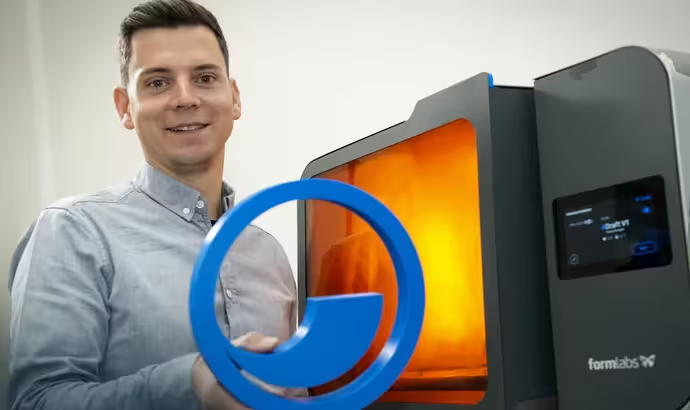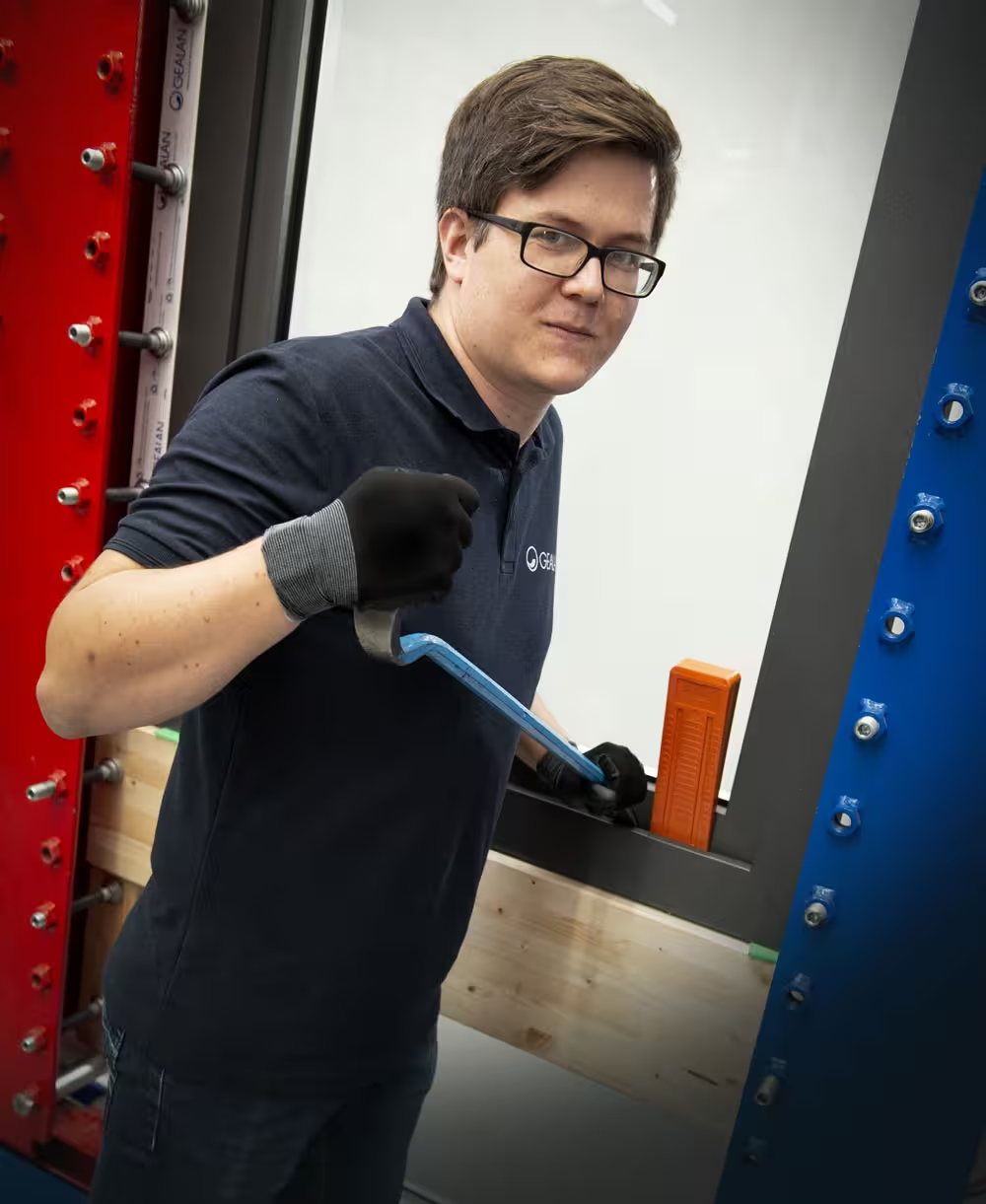Constructive paths

People working in GEALAN construction do more than just drawing. Philipp Benker and Kay Sommermann are designers with unexpected specialties. Two career paths that show that GEALAN doesn’t just offer jobs, but career development opportunities.
In cross-section, a GEALAN window profile looks quite complex, like a small maze with webs and cavities. Why is it like that? Philipp Benker and Kay Sommermann have to laugh at the question. For the two designers, profile geometry is the most obvious thing in the world: ‘There used to be two hollow chambers – a narrow one on the outside and an inner one for the steel, in other words, the reinforcement’, says Philipp Benker (33). ‘Over time, more chambers were added – three, four, and today there are five or six. They improve thermal insulation. The chambers are air-filled, and each layer of stagnant, non-circulating air is insulated.’ The nineties gave rise to a real chamber rally, adds Kay Sommermann (30). ‘But it has been shown that eight or more chambers do not produce better thermal insulation, while five or six generate excellent values.’ The outer chambers are exposed to heat from the sun and therefore need ventilation. The largest chamber is reinforced with steel, which makes the window a stable structural element. ‘There are many practical constraints’, says Kay Sommermann. ‘A profile with six chambers, as it is today, is the result of years of evolution. It meets all requirements.’ The two designers are convinced that the basic geometry will not change any time soon.
Finding the one solution that meets all requirements is the permanent task of the design department, which employs seven designers. When GEALAN develops a new profile system, the designers fiddle around with finely tuned geometric units, the exact position of the chambers and the thickness of the webs. But dozens of properties are determined from the outset, including functions, performance values and design. More specifically, this also means construction depth, face widths, statics, angles and radii, suitability for wet bonding, burglary protection, suitability for passive house compatibility, proportion of recycled material and so on. ‘Processability is another major aspect’, says Kay Sommermann. ‘Drilling axes must be placed properly, so that nothing needs to be converted in our customers’ processing centres. Also, the rollover heights of the frame and sash should be the same; otherwise, our customers would need different welding systems. Ease of processing is really crucial.’ The designers sketch what the new profile will look like, first on paper, then in CAD programmes, initially in 2D, then in 3D – and that for more than twenty different geometries per system. After all, a turn and tilt window needs a completely different profile than a lift-slide door. ‘With our software, we can perfectly model and calculate in advance how good the thermal insulation of a new system will be. Sound is a little more complicated – but at GEALAN, we have decades of experience, regardless of what the issue is. We know what works best, which is a huge advantage for every new development.’ Once the profile is designed, the tool shop starts to build the matching tools – and the designers move on to the accessories. Every end cap, every threshold bracket, every mullion connector is carefully considered, sketched and digitally drawn.
However, the design department not only constructs products, but also career paths. After his secondary school leaving certificate, Philipp Benker began an apprenticeship as a construction mechanic at the age of 15. In order to advance in his career, he attended a technical school in Dresden, specialising in mechanical engineering. Then he worked for a metal construction company for almost two years. When that company ran into difficulties, he started looking for a new job. In 2015, at the age of 25, he joined GEALAN as a design engineer. ‘For me, it was a really exciting task area. A designer needs technical understanding and spatial imagination. He has to be creative and get things done quickly and well.’ After being with the company for just one year, Philipp Benker was faced with a new challenge: 3D printing. ‘With the 3D printer, we can print out every profile and every accessory, which I found interesting right away.’ The 3D printer melts ABS plastic and builds it semi-fluidly into the desired three-dimensional object, layer by layer. A second 3D printer hardens synthetic resin with a laser and makes it possible to print completely different materials, from flexible to high-temperature resistant. ‘Both can be done overnight – and in the morning we already have the prototype in our hands. With it, we can judge much better than with a drawing whether the profile meets our expectations. It also helps us assess whether each of the forty accessories fits exactly, how the processing works, and whether the plug connections fit together well. The haptics are extremely helpful. We can still easily optimise something at this stage; and our customers can also already get an idea. 3D printing speeds up the entire profile development.’ Philipp Benker says he grew into 3D printing, and as his speciality grows, so does his career. Today, he is a Senior in the design department.
The course for Kay Sommermann’s career was set at a vocational training fair in Hof. With his secondary school leaving certificate fresh in his pocket, he noticed GEALAN at this fair and asked for an internship in the design department. ‘The whole work atmosphere impressed me. The colleagues were totally open and welcoming, and I felt at home right from the start.’ While others were still pursuing traditional technical draughtsman training, GEALAN already focused in 2010 on the technical product designer, who would work with CAD programmes earlier and more intensively. ‘So I thought to myself: cool, they are future-oriented!’ After the apprenticeship, Kay Sommermann was hired, but first he continued his training as a mechanical engineering technician in Hof. ‘I was still here during the summer holidays. The contact with GEALAN never broke off and in 2016 I returned to the design department.’ However, he was assigned to a new task area. He now increasingly deals with testing.

Every GEALAN profile has to successfully complete a testing marathon before it is launched on the market. As soon as the first window element is made from a new profile, it has to withstand hurricane-force air blasts in a test stand. It is massively ‘rained on’ – sometimes with 40 litres of water per minute. The window must remain tight, stable and functional. ‘We simulate storms of the century’, says Kay Sommermann. ‘In real life, such a storm would mean that I probably wouldn’t worry about the tightness of my windows, but rather about whether my house was still standing. Nevertheless, in the test environment, not a single drop of water can enter the room.’ Then we test the burglary protection: ‘We do the preliminary test internally, which means I slip into the role of the burglar and try to open the window element – with a screwdriver, then with a crowbar. The longer the window withstands, the higher the burglary protection. Official testing is then carried out by external testing institutes.’ The thermal insulation test also takes place externally. For this test, the element is placed in a hot box to prove that it transmits as little heat as possible. In a sound laboratory, the element is then subjected to a load of pink noise – a sound mixture across all frequency ranges – and it only achieves top ratings if it insulates the sound very well. Then the window undergoes a long-term function test in which years of use are simulated. Additionally, the Research & Development department carries out further material tests, for example, on colour fastness and gloss level. How a profile behaves in fire is also tested. And in order to receive a RAL quality mark, it must pass coupled tests, for example, to assess how stable and tight a window still is after ten heat/cold cycles. The inspectors then disassemble the element and examine it for the smallest cracks in the bonding. The RAL mark is only awarded if all standards are met.
Kay Sommermann has been Senior Testing Centre since 2019. You can sense his fascination when he talks about testing: ‘When something completely new is put to the test and something doesn’t work quite the way we imagined – thinking about it, finding out what we have to improve, finding the solution – that’s the most exciting thing for me.’ Even if he himself is no longer at the drawing board, his suggestions for improvement naturally affect the design, which further improves the profiles with the help of his ideas.
If there are so many fixed specifications when a new profile is designed – does design still have anything to do with creativity? Philipp Benker says: ‘Yes! When we’re working on a completely new system, there’s definitely freedom of design, allowing us to reconfigure the entire design. Whenever I design an accessory that is then sold and installed in masses internationally, that is a really good feeling!’ Finding the smartest solution within the many specifications and narrow limits – that is precisely the art, explains Kay Sommermann. ‘And we also have to be flexible. A single great idea and insisting on it is not feasible. Maybe the idea is quite good for one case, but the next customer needs something else – and then we have to think of new ways.’
Philipp Benker and Kay Sommermann both started out in the design department and discovered their specialties there. They continue to develop profile geometries and profiles, but also themselves. Kay Sommermann has long since completed his training as a window technician. Philipp Benker is striving to become a specialised technician. The career paths in the GEALAN design department remain under construction – and constructive.

Marc Schenk
07/11/2023
Latest articles

GEALAN from the inside
GEALAN from the inside
A really good tool for internal communication: GEALAN inside is anything but a bulletin board; the digital platform is a prime example of how internal company information can be bundled and prepared in a user-friendly way. GEALAN inside is packed with interesting facts and yet clear, offers umpteen functions and is easy to use. All those who work at GEALAN have their virtual meeting place – and on top of that, GEALAN inside looks chic too.

"Customers who challenge us"
"Customers who challenge us"
GEALAN has 2022 its premium system GEALAN-KONTUR®. It combines design-oriented Design language with convincing Technical Characteristics. Its development was a joint project between the system provider and two window manufacturers: Felbermayer and PaX. Robert Tänzel (45), Sales Head of Division at GEALAN, has talked to us with the two project partners. He tells of a challenging all sides Cooperation. And of other challenges he has tackled – long before he has joined GEALAN.

Through the eyes of a physicist
Through the eyes of a physicist
Cameras on, high quality: The optical control systems, GEALAN on the extrusion lines in Tanna, are a direct investment in quality. You will work with Artificial Intelligence and recognize on the profile surfaces almost every Deviation from the optimum. A droplet of water on the profile? No problem. A visible scratch or tiny bubble? Immediately used as Error reported – and that in extrusion speed, such decisions for the human eye almost impossible. Dr.-Ing. Winfried Bernhard (55), Head of GEALAN Quality Management and the man who GEALAN's quality offensive, looks at the new hardware, and nods. Nor are they a test, but how good the systems work and how closely they look, already fascinates him.